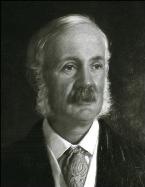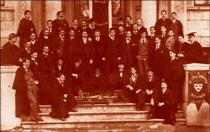1811
James McGill bequeaths Burnside, his beloved 46-acre estate, to the Royal Institution for the Advancement of Learning, along with £10,000 and the stipulation that a college bearing his name should be established on the site.
1854
Two major Montreal projects provide ample evidence of the immediate and future need for a corps of well-trained professional engineers: the Grand Trunk Railway builds the first railway bridge on the western tip of the island of Montreal (Sainte-Anne-de-Bellevue) while a feasibility study is undertaken on the construction of the Victoria Bridge.
1855
Sir William Dawson is installed as McGill’s fifth principal and begins a 38-year tenure (1855-1893), the longest term of any principal in the history of McGill.
A series of lectures in applied sciences is inaugurated by Principal Dawson within the Faculty of Arts. These lectures form the basis of a two-year curriculum leading to a diploma in Civil Engineering.
1857
In response to strong governmental interest in the establishment of rail and communications links between emerging urban centres, McGill institutes a course in Road and Railway Engineering.
The Grand Trunk Railway between Montreal and Toronto is completed.
1858
Oliver Gooding graduates from McGill with a degree in Civil Engineering. It is the first engineering degree granted in British North America.
1860
Considered by some to be the Eighth Wonder of the World, the Victoria Bridge spanning the St. Lawrence River opens. An engineering feat that was fêted around the world, the bridge allowed commerce trapped by Montreal’s winter-locked port year-round access to the United States – in particular to the port of Portland, Maine, which never closed.
1867
On July 1, Ontario, Quebec, Nova Scotia and New Brunswick are confederated as the new nation of Canada.
1871
A special grouping of instructional staff in the Faculty of Arts form the Department of Applied Science.
The Department of Mining Engineering is founded with Bernard J. Harrington (BA 1869, MA 1895, LLD 1899) as lecturer. Harrington had just received the new PhD designation from Yale University. Three years later he would become a professor in the department.
1872
The two-year Applied Science diploma within Arts is changed to a three-year, degree-granting program that awards its graduates with a Bachelor of Arts in Applied Science (BASc) degree. Regardless of faculty, most McGill students take engineering courses during their first year.

1873
Civil Engineering and Surveying is renamed Civil and Mechanical Engineering. There were then three divisions of study: Civil and Mechanical Engineering; Assaying and Mining; and Practical Chemistry.
The Department of Applied Science grants its first degrees. Annually from this year forward, one graduate is invited to join the teaching staff. The first division to benefit is Civil and Mechanical.
1874
Metallurgy is introduced as part of the program in Mining Engineering.
1875
Four years after its inception, the Department becomes the Faculty of Applied Science with authority to grant two degrees: Bachelor or Master of Applied Science. The new Faculty offers courses in Civil and Mechanical Engineering, Assaying and Mining, and Practical Chemistry.
1876
In Boston, Alexander Graham Bell invents the “electrical speech machine,” now known as the telephone.
1878
Appointed to the Department of Civil Engineering two years previously, Henry T. Bovey is named the first Dean of the Faculty of Applied Science. The Faculty included four divisions: Civil Engineering, Mechanical Engineering, Mining Engineering, and Practical Chemistry.
Frank Dawson Adams, a future Dean of the Faculty, graduates from McGill College where he studied geology, chemistry and metallurgy.

1880
Construction begins on the Canadian Pacific Railway.
1884
A $30,000 endowment from Barbara Scott in memory of her father facilitates the first named Chair in the Faculty – the William Scott Chair of Civil Engineering and Applied Mechanics. Henry Bovey is named the first chairholder in 1890.
William Graham earns the honour of being the first graduate in Mechanical Engineering at McGill as well as the first in Canada.
1885
Slated for completion in 1891, the CPR finishes well ahead of schedule when the historic final spike was driven in Craigellachie, British Columbia, by Donald A. Smith. He would be elected Chancellor of McGill in 1889, and later knighted Lord Strathcona.
1886
The first train on the CPR line arrives in Vancouver from Montreal in July of 1886. The historic engineering feat united the emerging country and allowed for greatly increased transcontinental commerce.
1889
The Faculty of Applied Science receives funds earmarked for its first buildings. After Thomas Workman’s generous 1885 bequest of $120,000 to go to a new building for the Department of Mechanical Engineering, Montreal tobacconist William C. Macdonald donates $460,000. Added to the more than $25,000 donated by other benefactors, these gifts allow the Faculty to proceed with plans for construction.
The Workman gift also provides for the second named Chair in the Faculty. The first Thomas Workman Professor is Charles A. Carus-Wilson.
1891
Macdonald’s generosity does not stop at the gift for a new building; it also provides for the establishment of the Department’s third Chair. Charles Carus-Wilson now becomes the first Macdonald Chair in Electrical Engineering. Additionally, Macdonald’s philanthropy provides for a Chair in Mining and Metallurgy, a Chair in Chemistry and three professorships. Macdonald’s generosity also provides the means to reduce the Faculty of Applied Science’s debt by $11,000 annually. It is estimated that over his lifetime, Macdonald gave more than $13 million to McGill. When he finally consented, in 1898, to being knighted (an honour he had twice refused), Queen Victoria described him as "the greatest philanthropist in education in the British Empire."
125 undergraduates enrol in the department’s first Electrical Engineering courses.
1893
For the first time in the history of McGill, buildings are constructed specifically to house engineers. The imposing Macdonald Engineering Building and the more modest Workman Technical Shops were both designed by architect Sir Andrew Taylor and his partner, William Gordon. Featuring a symmetrical Italian Renaissance façade and a Montreal limestone exterior, the five-storey Macdonald building is equipped to meet every conceivable need. Among the facilities housed on its five floors are an apparatus museum, a library, a forge, a foundry, and a dynamo and engine room.
1896
The School of Architecture is founded, the first in Canada. Endowed by William Macdonald, the Chair of Architecture is filled by the School’s founder, Stewart Henbest Capper. Macdonald also provides funds to meet the incidental costs of the School.
Construction begins on the Macdonald Chemistry and Mining Building, the second structure donated to the Faculty by William Macdonald, this one the result of a $240,000 gift. Renamed the Macdonald-Harrington Building in the late 1970s, it was designed by architect Sir Andrew Taylor after consulting with Harrington, the first Macdonald Professor of Chemistry.
1898
The name of the Engineering degree is changed to Bachelor of Science (BSc) and the degree of Bachelor of Architecture (BArch) is instituted.
The name of the Mining division is changed to Mining and Metallurgy.
1899
The School of Architecture graduates its first class – three students.